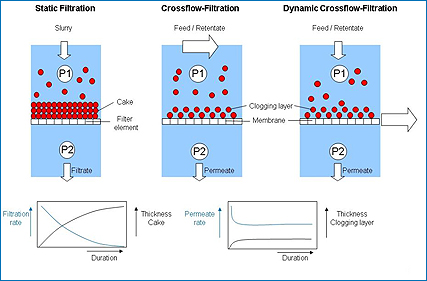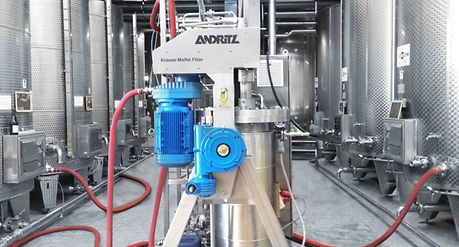Chemicals
Petrochemicals and polymers (latex), mineral oil, pharmaceuticals (antibiotics, injections, insulin), base chemicals, agrochemicals, speciality chemicals, natural rubber and bioplastics, chemical recovery
Crossflow methods for separating substances with poor filtration properties are state of the art. In chemical applications with solvents, abrasive materials, and similar, the use of ceramic filter membranes is gaining popularity.
Krauss-Maffei dynamic crossflow filter DCF
Ceramic membranes with overlap
Petrochemicals and polymers (latex), mineral oil, pharmaceuticals (antibiotics, injections, insulin), base chemicals, agrochemicals, speciality chemicals, natural rubber and bioplastics, chemical recovery
Dairy, wine, beer and juices (clarification, removal of fining agents), neutraceuticals and functional ingredients (proteins, enzymes), industrial fermentation (proteins, enzymes, yeast, E. coli), animal processing, bioprocess engineering products (proteins, enzymes, yeast, E. coli)
Pore sizes membranes/ filters | Ceramic (asymmetric): Ultrafiltration 1–80 nm; microfiltration 0.2–2 µm Metal: 1–200 µm |
Membrane area | 0.03–32 m2 |
Processable viscosity | up to 7,000 mPas |
Crossflow velocity | up to 7.3 m/s |
Shear stress | up to 140,000 Pa |
Operating feed pressure | 0-6 bar (isobaric processing possible) |
Operating TMP | 0.3–2.0 bar (lower than other crossflow technologies) |
In traditional cross-flow filtration, the development of a clogging layer on the surface of the filter membranes is prevented by pumping the feed. When handling sensitive or highly viscous products, this method is not efficient or not even feasible. In this case, traditional, circulating cross-flow filtration technologies would not be able to concentrate liquids to a highly viscous sludge. As dynamic cross-flow filtration (DCF) is able to concentrate the retentate to a sludgy consistency, the efficiency of the separation process and yield of the valuable compound are higher than from any other cross-flow technology. ANDRITZ KMPT has made further advances in the DCF process.

In this technology, overlapping, rotating discs generate a differential speed in relation to one another. This design creates a turbulent crossflow without using a pump to circulate the slurry. By applying wall shear stress that is at least 50% higher than in conventional crossflow systems, the formation of a clogging layer, which obstructs the permeate flow, can be avoided or at least reduced significantly. Ceramic filter membranes are installed as standard, but metal filter membranes can also be installed. Upgrades for existing plants, with a DCF being included downstream of a traditional crossflow filter, enhance the process, reduce energy costs, and increase the throughput. In any event, removal of bottlenecks is often the main reason for installing a DCF, and in some cases, the reduction of energy consumption is motivation enough.
Working principle of DCF
Every drop counts – higher solids concentration, higher yields for recovery of liquids. With its dynamic crossflow filter (DCF), ANDRITZ SEPARATION provides a highly efficient separation solution that fulfills the latest standards and is bridging gaps that common technologies have to bypass. Recovery of tank lees in wineries during vintage or wine purification, for example, is only one of the various applications of the DCF. It is a smart solution to increase yield, optimize quality, reduce costs, and improve working conditions.
| Model | Disk diameter (mm) | Number of membranes | Filter area (m2) | Retentate volume (l) | Length (mm) | Width (mm) | Height (mm) | Operating | Number of shafts |
| DCF 152/S | 152 | 1 | 0.03 | 0.4 | 500 | 400 | 600 | 30 | 1 |
| DCF 152/0,14 | 152 | 4 | 0.14 | 2.5 | 900 | 700 | 500 | 150 | 2 |
| DCF 312/2 | 312 | 16 | 2.1 | 60/40* | 1,700 | 1,500 | 1,800 | 1,200 | 2 |
| DCF 312/4 | 312 | 32 | 4.2 | 100/60* | 1,700 | 1,500 | 1,800 | 1,280 | 2 |
| DCF 312/6 | 312 | 48 | 6.3 | 130/80* | 1,300 | 1,500 | 1,900 | 1,350 | 2 |
| DCF 312/8 | 312 | 64 | 8.4 | 170/100* | 1,300 | 1,000 | 2,100 | 1,400 | 2 |
| DCF 312/10 | 312 | 80 | 10.5 | 200/120* | 1,300 | 1,000 | 2,300 | 1,450 | 2 |
| DCF 312/16 | 312 | 128 | 16.4 | 300/180* | 1,400 | 2,300 | 2,500 | 2,550 | 2 |
| DCF 312/20 | 312 | 160 | 20.5 | 350 | 1,450 | 2,400 | 2,500 | 2,900 | 4 |
| DCF 312/24 | 312 | 192 | 24.6 | 400 | 1,500 | 2,500 | 2,500 | 2,900 | 4 |
| DCF 312/28 | 312 | 224 | 28.7 | 450 | 1,550 | 2,600 | 2,600 | 3.150 | 4 |
| DCF 312/32 | 312 | 256 | 32.8 | 500 | 1,600 | 2,600 | 2,600 | 3,400 | 4 |
*= round/ oval housing available. All technical data are approximate and subject to change without notice.
For most of the players in food and chemical industries, using a Dynamic Crossflow Filter (DCF) is an efficient way to filtrate different products but today, operations need significant improvement to gain in productivity and reduce OPEX, which is now possible thanks to Metris addIQ digital twin solution.
A digital twin is a digital replica of the physical process using asset-specific information such as actual physical dimensions and equipment characteristics. It runs in parallel with operations, continuously calculating key process parameters which sometimes cannot be measured or are difficult to measure by traditional instrumentation. Through proven simulation capabilities, combined with live plant data as an input provides virtual transmitters, it calculates continuously the optimal flow setpoint, and performs what-if scenario analysis.
Improve your operation with Metris Digital Twin
Process calculations by Digital Twin: All trends accessible on Metris platform






